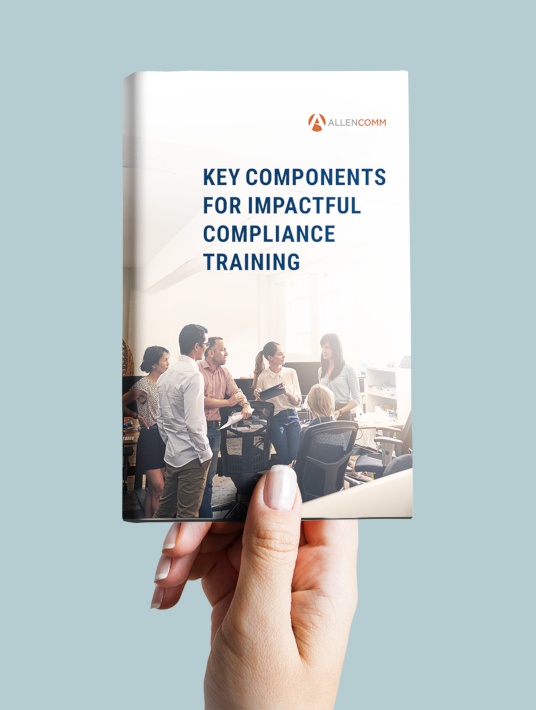Compliance Training Best Practices: Principles, Tips, And How To Choose Your L&D Partner
Johann Wolfgang von Goethe’s quote “Knowing is not enough; we must apply. Willing is not enough; we must do” probably wasn’t a reference to the modern Learning and Development departments, but his point was obvious: It is time to take action.

Theoretically, building training that covers all of your company's risks is quite easy. In reality, successful compliance training is one of the hardest programs to create, as ‘compliance’ is another word for ‘rule’ – and we all know how attractive this word can be. However, there are ways to make compliance fun (i.e. interesting) for your employees, as long as you know some tips and tricks that will change the way you (and your staff) see compliance for ever.
Let’s begin.
4 Principles Of Impactful Compliance Training
A fully comprehensive compliance training strategy can have many elements. Depending on the complexity of the business and its regulatory environment, it might have quite a few more than the four that follow. But at a basic level, the timeless principles of clear goal setting, good communication, focused design, and verification are the four corners of a solid foundation.
1. Well-Defined Goals
What behavior do you want to change? The ultimate goal of compliance training is full adherence to all regulations that apply to the business; but to get there, employee behavior must change. So, all smaller goals that support the big one must be defined.
2. Good Communication
Without a clear view of the ultimate goal, compliance training can feel like trying to walk through a large field and getting lost deep in the weeds. The little details are important, but if employees are only concerned with memorizing them, they risk losing motivation and may consider the training a painful experience.
3. Focused Instructional Design
When training is customized for each person and their specific responsibilities, critical information is emphasized, and understanding is verified, while "good-to-know" content only plays a supporting role. Partnering with a designer experienced at custom content development[2] is an effective way to do this.
4. Monitoring To Verify Results
Any business expense must be measured against its effect on the bottom line. In the case of compliance training, that means adherence to the regulations must be verified. A proactive monitoring program should include procedures that verify the training was properly absorbed. For example, tracking the number of worker’s compensation claims before and after compliance training would verify employees are following the procedures they were trained on.
Keep on reading to discover the best approaches to compliance training, when to look for outside help, and what you should look for in a training vendor.
Compliance Training Best Practices: Interactive Video
One of the best approaches to compliance training is to immerse the learner in an environment where good habits become second nature. When the regulatory environment changes (or compliance is already weak) and consequences of failure are high, immersive compliance training is required. Simply reading a manual or sitting through a PowerPoint session won't do the job, and standard off-the-shelf solutions tend to fall short as well.
Immersive training creates a world where learners can acquire knowledge, pick up good habits, and develop skills to do the right thing even in novel situations. Immersive training environments tend to do the following:
- Teach the learners about the dangers inherent in critical situations to underscore the importance of the subject matter. For example, in a public works training module, a welcome video showing the intense situations workers face in a crisis situation establishes the critical nature of knowing how to quickly respond and interact effectively with first responders. This gives learners a vivid picture of what’s at stake and helps them relate to the subject matter on a personal level.
- Speak the learner’s language by working closely with subject matter experts to strike the right tone. A malpractice avoidance training incorporates scenarios and questions that have been painstakingly crafted to speak directly to highly accomplished experts.
- Use a multi-media approach that includes audio, video, real-life case studies, complex scenarios, and challenging decision points to boost retention and give learners a complete, three-dimensional view of their environment.
When failure is not an option, employees must comply with regulations perfectly and must anticipate risky, potentially non-compliant situations. Compliance training that incorporates interactive video, immersive scenarios, tough decision points, and a strong personal connection to the subject matter is, by far, the best tool to achieve these goals.
Compliance Training Best Practices: Gamification
Although gamifying compliance may sound anti-intuitive, there can be real benefits. Employees who take gamified compliance training have the potential to become more engaged with the material, apply their knowledge in a realistic context, and gain greater empathy. Let’s take a closer look at giving games a bigger role in compliance training
The unfortunate reality of workplace harassment is that some perpetrators don’t even realize that what they’re doing is harassment[1].
They’re not the only ones in the dark—victims often don’t know they were sexually harassed[2], either. Since real life is rarely cut-and-dry, other compliance issues are also difficult to recognize.
Whether something is an ethics or OSHA violation may be unclear, too. Although these issues may not be recognized, they affect the company culture and morale, which can directly impact employee retention.
Unfortunately, traditional compliance training does nothing to solve this issue.
Stifling courses full of legalese only serve to confuse employees and muddy their understanding of the subject, and any rote scenarios tacked to the end of the legal dump don’t address the true nuance and complexity of the situation. It’s more helpful to immerse those taking the training in a gamified scenario, which allows for the more complicated situations[3] that are true to life.
It’s a toss-up as to whether the true-to-life capabilities of gamification can make people more empathetic. Some researchers say yea[4]. Some say nay[5]. But even though games that allow users to embody someone from a different walk of life may not guarantee an increase in empathy, they still have the potential to do so. Like books and movies, games allow participants to get into the heads of those who aren’t like them.
Emotions like empathy hit home where dry legal logic can’t. Someone who was previously unmoved by a legal course but who feels empathy through a game is less likely to be unethical, skirt OSHA requirements, or submit others to inappropriate comments once they see how those violations negatively impact a person whose viewpoint they’ve adopted.
Collaboration: Which L&D Partner Is The Best Fit For You?
If the decision has been made to revamp or enhance your compliance training, finding a reliable development partner is incredibly important, and perhaps a little daunting. With the sheer volume of vendors just a Google search away, it’s easy to be overwhelmed. How can you know which L&D partner is the best fit for your training project?
When collaborating with an outside team to create your training, it’s important that they have an accurate picture of your learners. The team needs to quickly understand how your employees’ day-to-day responsibilities are influenced by compliance training. They also need to provide effective ways to engage your learners throughout the training.
Will they understand the needs of your employees and your company? Will they be able to provide a solution that is flexible and scalable?
The process of creating training solutions should be a genuine partnership between your company and any outside L&D team. You’ll be trusting them with sensitive company information, and they, in turn, should capture your company’s culture and values in each training module.
When looking for that collaborative L&D team, focus on what will make your compliance training succeed.
Focus On Your Company Needs
A good partner will help you create training that adequately outlines the rules and standards[6] that will keep your company safe while simultaneously communicating your company’s values and culture. A collaborative L&D team will ask you:
- What goals does the organization wish to accomplish through this training?
- What requirements, if any, are necessary to be included in order to comply with regulation?
- What tools and technologies should be used? Is there room in the budget to invest in innovating strategies?
- What time frame will the corporate compliance training project have? When is the deadline for launch?
- What components will be developed? Web-based training? Instructor-led training? Performance support job aids? A combination?
- What areas of the project could be performed in house?
Focus On The Scale Of The Solution
As you examine your potential partners for your corporate compliance training, look carefully at their process. A collaborative L&D team will consider flexibility when designing your solution. If their process is built on a solid foundation but allows for flexibility on top of its structure, your partnership is less likely to end in a clash over process styles. Likewise, keep an eye out for a vendor’s ability to scale to your needs[7]. You’ll want to find a vendor that has the capability built into their services to scale for your audience size as it grows and changes.
Final Word
Providing top-notch compliance training for your employees is your opportunity to control the message of what behaviors will be expected and what consequences will be enforced in your workplace. It’s an effective strategy for communicating, building, or even changing your company culture into a culture you want.
References:
- Survey Shows 1 in 3 Men Don’t Think Catcalling is Sexual Harassment, The Atlanta JournalConstitution, Fiza Pirani
- Why I Didn’t Do Anything About Being Harassed At Work, FairyGodBoss, Alicia Ostarello
- A Video Game That Wants to Stop Sexual Harassment, The New Republic, Rachel
- Teaching Empathy With Video Games, Edutopia, Matthew Farber
- Stop Expecting Games to Build Empathy, Wired, Julie Muncy
- 3 Tips For Finding A Reliable Partner To Implement And Scale Your Compliance Training Program , eLearning Industry, David Peterson
- Corporate Compliance Training: How AllenComm Can Scale Your Training Meeting Compliance And Regulatory Standards, eLearning Industry, Daniel Sowards









